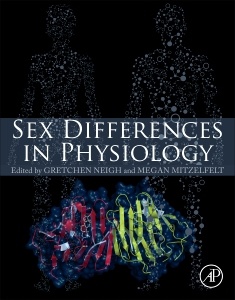Description
Sex Differences in Physiology
Coordinators: Neigh Gretchen, Mitzelfelt Megan
Language: English
Subjects for Sex Differences in Physiology:
Keywords
<; P>; Sex differences; gender; physiology; sex chromosomes; hormones; neuronal signaling; autoimmunity; infection; chromosomes; cardiovascular; lung function; respiratory tract; kidney control; acid-based balance; GI function; metabolism; exercise physiology; estrous cycle monitoring; gonadectomy; four-core genotype mouse models; hormonal supplements<; /P>
236 p. · 21.4x27.6 cm · Paperback
Description
/li>Contents
/li>Biography
/li>Comment
/li>
Sex Differences in Physiology is an all-encompassing reference that details basic science research into sex differences in all physiological fields. It includes scientific discoveries concerning sex differences in cardiovascular, respiratory, renal, gastrointestinal, and musculoskeletal physiology. In addition, coverage of the development, endocrinology, neurophysiology, immunity, and metabolism is included, making this important reference a resource that will meet the needs of investigators interested in incorporating sex differences into their research programs, while also providing clinicians with the basis for providing the best sex-based medical treatment options available.
1. Introduction by Virginia Miller
2. Endocrinological origins of sex, sexual differentiation, and sexual dimorphisms by Craig Kinsley, Kelly Lambert, and Massi Bardi
3. Sex differences in neuroanatomy and neurophysiology: implications for brain function, behavior, and neuropsychiatric disease by Gretchen Neigh and Liana Merrill
4. Sex differences in the immune system and immune function by Sally Huber and Delisa Fairweather
5. Sex and gender differences in cardiovascular disease by Leanne Groban, Hao Wang, Allan Alencar and Sarah Lindsey
6. Sex differences in pulmonary anatomy and physiology: implications for health and disease by Y.S. Prakash and Venkatachalem Sathish
7. Sex differences in renal physiology and pathophysiology by Carolyn Ecelbarger
8. Sex differences in gastrointestinal physiology and disease: from endogenous sex hormones to environmental endocrine disruptor agents by Eric Houdeau
9. Sex and gender differences in body composition, lipid metabolism and glucose regulation by Kelly Ethun
10. Sex hormone influenced differences in skeletal muscle responses to aging and exercise by Peter Tiidus
11. Strategies and approaches for studying sex differences in physiology 11.1. Introduction by Margaret McCarthy 11.2. Studying Sex Chromosome Effects that Cause Sex Differences in Non-Gonadal Phenotypes by Arthur Arnold 11.3. Organizational influences of the sex steroid hormones on the hypothalamic-pituitary- adrenal (HPA) axis by Victor Viau 11.4. Activation Methodologies by Jill Becker 11.5. Human Methodologies in the Study of Sex Differences by Emily Bartley and Margarete Ribeiro-Dasilva
Dr. Neigh has received funding from the National Alliance for the Study of Schizophrenia and Depression (NARSAD), the Brain and Behavior Research Foundation, the American Heart Association, the Claude Pepper Center, the National Institute of Neurological Disorders and Stroke, the National Institute for Nursing Research, the National Institute of Allergy and Infectious Disease, and the National Institute of Mental Health. In addition to her research program, Dr. Neigh serves on the Executive Committee of the Organization for the Study of Sex Difference (OSSD) and the editorial boards of Hormones & Behavior and Physiology & Behavior. More information about her work can be found at: http://gretchenneigh.wix.com/neighlab
Dr. Megan Mitzelfelt has primary research interests in sex hormone regulation of epithelial transport and its role in the sex differences observed in normal physiology and disease. Most currently her research involves understanding the regulation of alveolar epithelial sodium channels by estradiol. Using cell-attached patch clamp and biochemistry, she is investigating the mechanism of estradiol’s activation of the epithelial sodium channel in a rat alveolar cell line. In future studies, she will e
- Provides a sweeping, organ-by-organ review of currently observed sex differences in animal models and human disease
- Explains how sex differences influence physiology and disease
- Provides the critical knowledge on sex differences for better understanding of prevention and treatment of diseases




